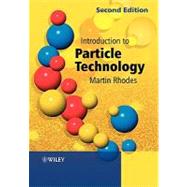
Note: Supplemental materials are not guaranteed with Rental or Used book purchases.
Purchase Benefits
Looking to rent a book? Rent Introduction to Particle Technology [ISBN: 9780470014288] for the semester, quarter, and short term or search our site for other textbooks by Rhodes, Martin J.. Renting a textbook can save you up to 90% from the cost of buying.
| Particle Size Analysis | |
| Introduction | |
| Describing The Size Of A Single Particle | |
| Description Of Populations Of Particles | |
| Conversion Between Distributions | |
| Describing The Population By A Single Number | |
| Equivalence Of Means | |
| Common Methods Of Displaying Size Distributions | |
| Methods Of Particle Size Measurement | |
| Sampling | |
| Worked Examples | |
| Exercises | |
| Single Particles in a Fluid | |
| Motion Of Solid Particles In A Fluid | |
| Particles Falling Under Gravity Through A Fluid | |
| Non-Spherical Particles | |
| Effect Of Boundaries On Terminal Velocity | |
| Further Reading | |
| Worked Examples | |
| Exercises | |
| Multiple Particle Systems | |
| Settling Of A Suspension Of Particles | |
| Batch Settling | |
| Continuous Settling | |
| Worked Examples | |
| Exercises | |
| Slurry Transport | |
| Introduction | |
| Flow Condition | |
| Rheological Models For Homogeneous Slurries | |
| Heterogeneous Slurries | |
| Components Of A Slurry Flow System | |
| Worked Examples | |
| Further Reading | |
| Exercises | |
| References | |
| Colloids and Fine Particles | |
| Introduction | |
| Brownian Motion | |
| Surface Forces | |
| Result of Surface Forces on Behaviour in Air and Water. | |
| Influences of Particle Size and Surface Forces on Solid/Liquid Separation by Sedimentation | |
| Suspension Rheology | |
| Influence of Surface Forces on Suspension Flow | |
| Nanoparticles | |
| Worked Examples | |
| Exercises | |
| References | |
| Fluid Flow Through a Packed Bed of Particles | |
| Pressure Drop-Flow Relationship | |
| Filtration | |
| Further Reading | |
| Worked Examples | |
| Exercises | |
| Fluidization | |
| Fundamentals | |
| Relevant Powder And Particle Properties | |
| Bubbling And Non-Bubbling Fluidization | |
| Classification Of Powders | |
| Expansion Of A Fluidized Bed | |
| Entrainment | |
| Heat Transfer In Fluidized Beds | |
| Applications Of Fluidized Beds | |
| A Simple Model For The Bubbling Fluidized Bed Reactor | |
| Some Practical Considerations | |
| Worked Examples | |
| Exercises | |
| Pneumatic transport and standpipes | |
| Pneumatic Transport | |
| Standpipes | |
| Further Reading | |
| Worked Examples | |
| Exercises | |
| Separation of Particles | |
| Gas Cyclones Description | |
| Flow Characteristics | |
| Efficiency Of Separation | |
| Scale-Up Of Cyclones | |
| Range Of Operation | |
| Some Practical Design And Operation Details | |
| Worked Examples | |
| Exercises | |
| Storage and Flow of Powders Hopper Design | |
| Introduction | |
| Mass Flow And Core Flow | |
| The Design Philosophy | |
| Shear Cell Tests | |
| Analysis Of Shear Cell Test Results | |
| Summary Of Design Procedure | |
| Discharge Aids | |
| Pressure On The Base Of A Tall Cylindrical Bin | |
| Mass Flow Rates | |
| Conclusions | |
| Worked Examples | |
| Exercises | |
| Mixing and Segregation | |
| Introduction | |
| Types Of Mixture | |
| Segregation | |
| Reduction Of Segregation | |
| Equipment For Particulate Mixing | |
| Assessing The Mixture | |
| Worked Examples | |
| Exercises | |
| Particle Size Reduction | |
| Introduction | |
| Particle Fracture Mechanisms | |
| Model Predicting Energy Requirement And Product Size Distribution | |
| Types Of Comminution Equipment | |
| Worked Examples | |
| Exercises | |
| Size Enlargement | |
| Introduction | |
| Interparticle Forces | |
| Granulation | |
| Worked Examples | |
| Exercises | |
| Notation | |
| Health effects of fine powders | |
| Introduction | |
| The huma | |
| Table of Contents provided by Publisher. All Rights Reserved. |
The New copy of this book will include any supplemental materials advertised. Please check the title of the book to determine if it should include any access cards, study guides, lab manuals, CDs, etc.
The Used, Rental and eBook copies of this book are not guaranteed to include any supplemental materials. Typically, only the book itself is included. This is true even if the title states it includes any access cards, study guides, lab manuals, CDs, etc.